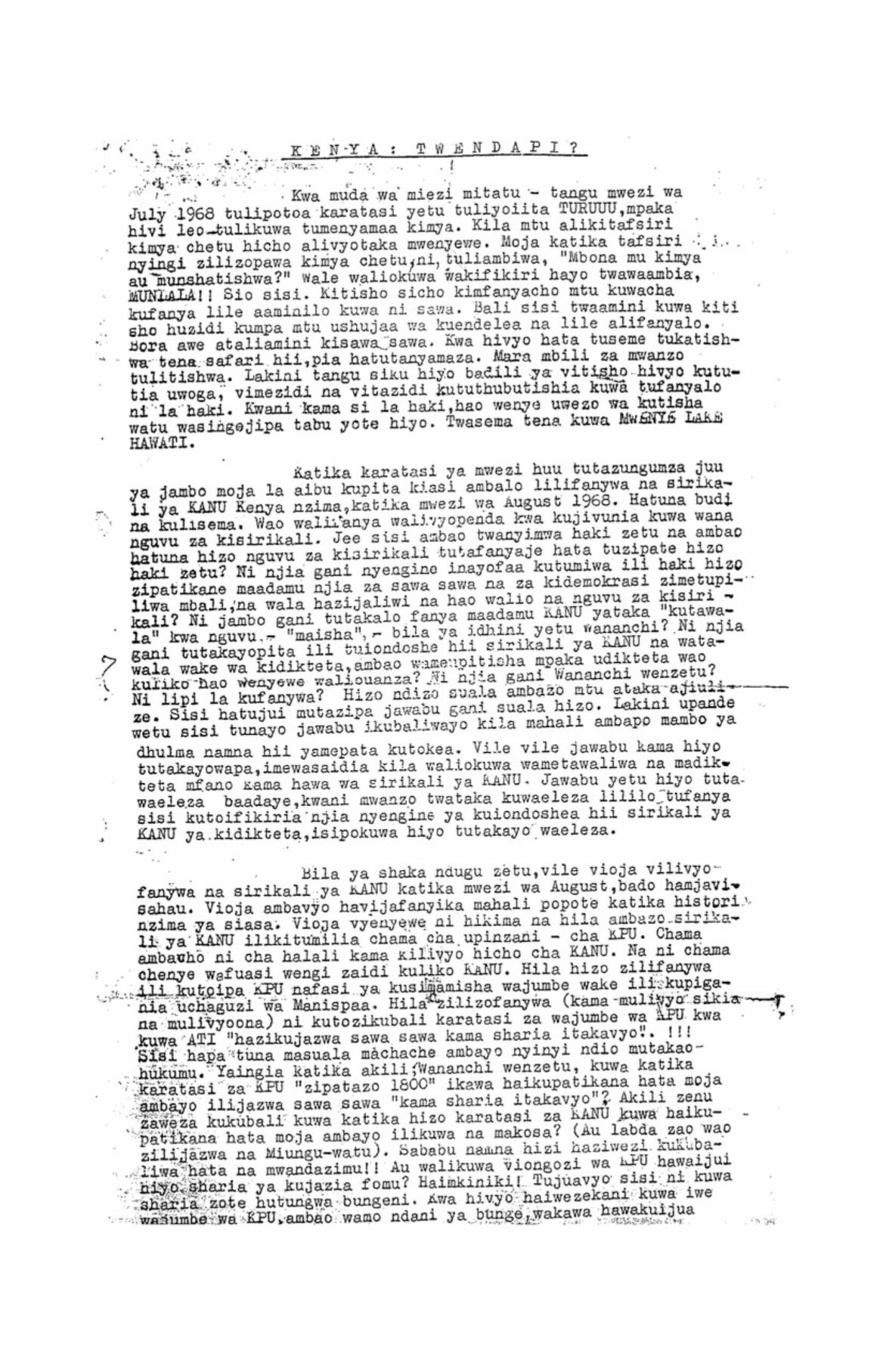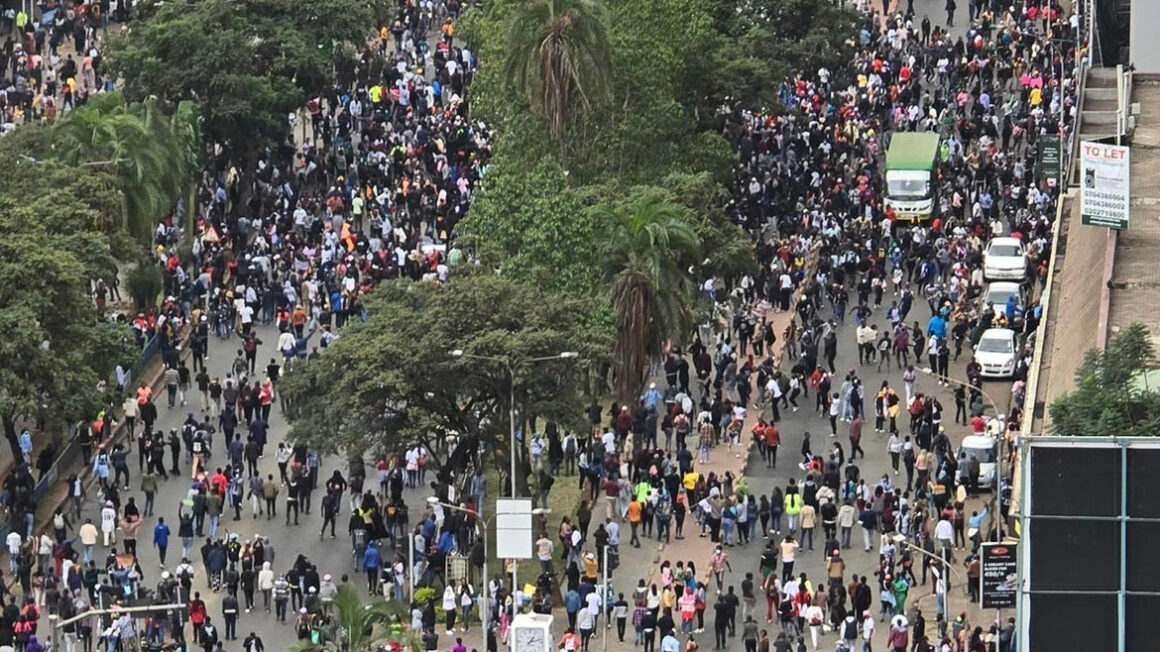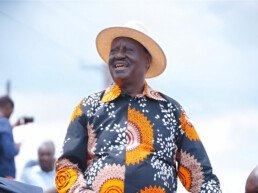What gives music its strength in protest isn’t just what it says, but what it makes people feel, and how vividly it helps them see. Few forms move as easily between the personal and the collective as music. A single track, often just a few minutes long, can evoke immediate feeling, then unfold new meanings with every listen. Where a film or novel demands time, music rewards both fleeting encounters and deep immersion. It begins with rhythm or mood, then the gradual revelation of lyrical nuance, then you notice the vocal texture and the subtle arrangement choices. This layered accessibility makes music uniquely positioned to stir memory, shape thought, and travel across borders, generations, and ideologies.
A Brief history of Protest Music in Kenya
At independence, Kenya came under the leadership of Jomo Kenyatta, whose years in Europe had shaped a broader understanding of how cultural forms like music, literature, and performance could serve political ends. Although institutions like the Kenya Cultural Centre and Kenya National Theatre had been established during colonial rule under the Kenya Cultural Centre Act of 1951, Kenyatta’s government actively embraced and reoriented them to serve their nation-building agenda. These platforms promoted music, drama, and performance, but also became channels through which state-sanctioned narratives were reinforced. Much of the work presented during national functions mythologized the independence struggle, placing Kenyatta at its center and casting him in near-reverential terms.
Over time, the KANU government under Kenyatta grew more authoritarian. Artists who challenged the state risked surveillance, arrest, and in some cases, death. One of the earliest critics was Abdilatif Abdalla, a writer and activist whose 1968 essay Kenya: Twendapi? (“Kenya, Where Are We Headed?”) sharply criticized Kenyatta’s leadership and voiced support for the opposition Kenya People’s Union, a socialist party led by Oginga Odinga. Abdilatif was arrested, charged with conspiracy, and sentenced to three years in prison, much of it in solitary confinement at Shimo La Tewa. The Kenya People’s Union party was banned in 1969.

Daniel Arap Moi inherited and expanded the cultural strategies established under Jomo Kenyatta, where music and performance had been used to reinforce the image of the president as the face of the nation. While Kenyatta’s government promoted official narratives through institutions like the Kenya Cultural Centre and the Kenya National Theatre, it was under Moi in the 1980s that this approach became more structured and centralized. The creation of the Presidential Music Commission (PMC) under Moi formalized the state’s role in curating and controlling musical output, particularly for national celebrations and political rallies. Operating from the Office of the President, the PMC promoted songs that praised Moi, portrayed him as the father of the nation, and emphasized unity under his leadership. Despite state efforts to control cultural expression, music remained a powerful outlet for dissent. Artists like Joseph Kamaru, D.O. Misiani, and others used their craft to speak against repression and corruption. Their songs carried the weight of collective frustration, offering listeners a language for their own unspoken fears. In a political climate where even a word out of place could draw the wrath of the state, these artists became chroniclers of what it meant to live under pressure and to resist it.
Kalamashaka, also known as K-Shaka, emerged from Nairobi’s Dandora estate in 1995, giving a raw, street-level voice to a new generation. Composed of members Oteraw, Kama, and Johny, the group broke through with their 1997 hit Tafsiri Hii. In it, they captured the despair and distrust that defined life for many urban youth under the Moi regime:
Kwenye kona, nakumbuka saa mbili
Nikiona yule mzee akishikwa koo, balaa
Nashindwa, nikimbilie nani?
Jambazi? Hapana.
Polisi? Hapana,
Watanitia pingu hata bila sababu…
In 2001, Eric Wainaina released Nchi Ya Kitu Kidogo, a searing critique of Kenya’s deeply entrenched culture of bribery. The song struck a national nerve, laying bare the corruption woven into everyday life, where even the most basic services required “something small” to move forward. The music video featured John “KJ” Kiarie, then a member of Redykyulass, the daring comedy trio known for parodying Kenya’s top political figures, including President Moi himself. Alongside Walter Mong’are and Tony Njuguna, KJ used satire to challenge the boundaries of public discourse in a tightly policed media environment. In a surprising twist, Moi reportedly found the impersonations amusing and regularly watched their clips, a brief moment of tolerance in an era better known for silencing dissent. Years later, Kiarie would join mainstream politics and now serves as a Member of Parliament and vocal supporter of the William Ruto-led administration, a government facing many of the same criticisms Nchi Ya Kitu Kidogo first brought to light.
Sitasimama Maovu Yakitawala
In the years that followed, more artists stepped into the space of political critique, using music to confront the failures of the state and society. From the early 2010s, a wave of artists began using music to interrogate the state of the nation with renewed urgency. Jimwat’s Sitoi Kitu Kidogo (2011) tackled everyday corruption head-on, urging citizens to reject the culture of bribes. Juliani’s Utawala (2013) followed with a powerful refusal to remain silent in the face of oppression. “Sitasimama maovu yakitawala”, he affirms. Sarabi Band’s Sheria (2014), featuring Juliani, pushed further, confronting the disconnect between the promises of law and the reality on the ground. Dorphan’s Mashujaa (2016) honored everyday heroes left out of official narratives, while Sauti Sol and Nyashinski’s Tujiangalie (2018) challenged a generation to look inward and reckon with its own complacency.
June 2024 in Kenya
On 20th June 2024, I was in the heart of Nairobi, in the midst of a large crowd, wearing comfortable clothes and a mask, ready for a running battle with Kenya’s often violent police personnel. That’s when I heard it, that simple chant that would come to define the past one year in Kenya’s social and political space. “Ruto Must Go” the chant grew louder and louder. Within minutes, the whole crowd was chanting rhythmically and there was even a refrain developing. Soon it became a call and response, with the responsibility of keeping the chant alive split between two indistinct halves of one crowd. What began as outrage over a punitive Finance Bill quickly swelled into one of the largest waves of protest the country had seen in a generation.
“When the country breaks, the one who asked to lead must answer.”
Even after the protests subsided, the chant didn’t. It echoed in nightclubs, churches, social halls, any space where Kenyans gathered. In moments of silence, it could flare up without warning, transforming ordinary pauses into political rupture. “Ruto Must Go” persisted not just as a slogan, but as a verdict. In three words, it distilled the anger and exhaustion of a nation facing economic strain, government excess, and shrinking civic space. The chant endured because it stripped away the excuses, naming not just the system, but the man at the top. For many, it was a reminder that leadership is accountability, and when the country breaks, the one who asked to lead must answer.
Ruto Must Go
The chant is not going away because it continues doing what broken institutions won’t. In fact, it has now permeated all strata of Kenyan society, articulating collective anger in a way no policy paper or manifesto ever could. Its rhythm is simple, its message unmistakable. In just three words, it has done what speeches failed to: name the problem, rally the public, and demand accountability.

The Kenyan youth-led protests of 2024 had far reaching effects on the social and political climate of the country. Across towns and cities, tens of thousands took to the streets, from all walks of life, demanding change. But the cost was devastating. Over 60 lives were lost, all at the hands of police. Hundreds more were injured, some permanently. The government was forced to withdraw the Finance Bill at the center of the unrest, as public outrage grew and the president, facing a crisis of legitimacy, brought the opposition into government to shore up his slipping grip on power.
In the midst of all of this, artists all over Kenya were working on music to commentate, commemorate and commiserate with the protests. Occupy The Streets was the first song to hit the public consciousness about the protests. Released on June 20th 2024, in the heart of the protest period, the rap single by Trio Mio perfectly captured the feelings of the protestors at the time. Lyrics about poor leadership, unfulfilled promises, the cost of living and the increase in taxation expressed clearly what the grievances were. The song and subsequent music video went viral and was a clarion call for more people to join the protests.
Though several protest songs emerged during the days leading up to and during demonstrations, it was the period that followed when the floodgates truly opened. As President Ruto’s regime faced growing public discontent, more artists stepped forward, their music echoing the frustration and urgency on the ground. In July 2024, Fancy Fingers of Sauti Sol released We Will Never Forget, a five-track EP featuring a lineup of well-known Kenyan artists. The project captured the emotional landscape of the moment, from anger and grief to resilience and the enduring hope for something better.
Kenyan Protest Music
This was followed by releases by various artists over the next one year with different genres being represented in what became a record of the grievances that ordinary Kenyans had towards the government of president Ruto. Songs such as Billy Black’s Soul Heavy, Sabi Wu’s Reject Hio Bill, 1Jau’s Ungana and Onedown’s Nitunogete reflected on the mood of the country in the midst of and after the protests. The themes prevalent on these records were those of fatigue, betrayal, and a flicker of hope. They reflected growing public concern over the state of the nation, and a belief, however faint, that change is still possible.
The music released during the protests gained traction fast as young Kenyans actively shared and amplified it in support of the movement. Songs, chants, and soundbites circulated widely online, driven by Kenya’s young and digitally active population. Platforms like Instagram, TikTok, and Twitter (now X) became central to how people organized, informed each other, and responded to events in real time. From coordinating the release of arrested activists to documenting key moments through memes and music, digital spaces became the main arena for civic action.
Much of the content was repurposed from things people were already familiar with. Political speeches, religious songs, and everyday phrases were reworked into protest material. This remix culture allowed people to respond quickly and creatively to government messaging. Editors used widely recognized music and language to make videos that were shared by hundreds of thousands within hours. DJs also played a major role. In clubs, university campuses, and public gatherings, they led chants mid-set and gave space for political expression through music. “Ruto Must Go” became a recurring phrase, not in official speeches, but shouted by crowds during musical breaks, underscoring how protest was finding space in cultural moments, not just political ones.
At the same time, traditional media outlets like Royal Media Services and Nation Media Group lost their position as the main source of information. Many turned instead to new media platforms like Nairobi Gossip Club, which offered frequent updates and were perceived as more in touch with public sentiment. For some, this shift felt minor, but for many others, it marked another loss from the bank of trust the public has in traditional journalism. People were placing their faith in blogs, podcasts, and social media to tell them what was happening.
The Power of the Song
As the music spreads so does its message, which is why so many repressive regimes are afraid of the song’s potential. Under a dictatorship, music and the arts are one of the first things to be regulated, because of their potential to inspire and effect change. Musicians are icons and role models to many and when they speak their audiences listen. Artists who openly supported the protests and spoke out about the issues their fellow citizens were facing experienced a noticeable shift in public perception. Their visibility and boldness elevated them in the eyes of many, turning them into cultural heroes.
At a time when silence was seen as complicity, those who stood with the movement, especially artists who showed up on the ground, were praised for their courage and sincerity. One such figure was Kenyan artist Charisma, whose long-standing criticism of government failures aligned naturally with the moment. His presence on the frontlines deepened his connection with fans, boosting both his credibility and career.
Dennis Ombachi
Another vocal public figure during the 2024 protests was former rugby star and popular food creator Dennis Ombachi, known online as The Roaming Chef. Having built a massive following on TikTok, Twitter, and Facebook through his cooking content and personal story of mental health advocacy, Ombachi used his platform to consistently amplify the movement. He joined demonstrators in Nairobi’s CBD, served lunch to protesters, and shared updates and calls to action with his millions of followers. His presence on the ground and persistent online engagement turned his platform into a powerful tool for solidarity, blending raw honesty, visibility, care, and conviction in a way that resonated across audiences.
Meanwhile, creatives and culture makers seen as aligning with the regime faced public backlash, including boycotts of their music and live shows. Some, recognizing the shift in sentiment, publicly apologized to their audiences.
A Story with a Long History
The role artists played in 2024 stood out, but it didn’t begin there. In Kenya, music and art have always found their way into moments of resistance, from village gatherings to urban stages, from underground studios to street murals. Long before these protests, creatives were raising uncomfortable questions, calling out injustice, and reminding the public of its power. What 2024 did was bring that work to the forefront. Musicians, painters, photographers, filmmakers, chefs, writers, and other cultural practitioners didn’t just respond to the moment, they became part of the movement. Their voices carried the message further, their work captured what words couldn’t, and their presence gave people something to rally behind.
2024 in Kenya made one thing clear: creativity is not separate from struggle, it is one of its sharpest instruments. We were reminded that protest isn’t limited to the streets, it can live in rhythm, in image, in story. When institutions fall short, it’s not only policy or politics that respond, it’s also culture. And in moments like 2024, that matters.
Hafare Segelan
Hafare Segelan is a music writer, critic, curator and content creator who is the brainchild behind two popular podcasts, Surviving Nairobi and Breaking Hertz. His work has been featured on platforms such as Spotify, Apple Podcasts, The BBC and many more. You can find him on Bluesky as @hafare.bsky.social
1 Comment
Comments are closed.





Nice reading! Also, dont forget how some songs that were not originally made for protest like anguka nayo ended up becoming part of the movement. It says a lot about how people reframe meaning based on the moment…